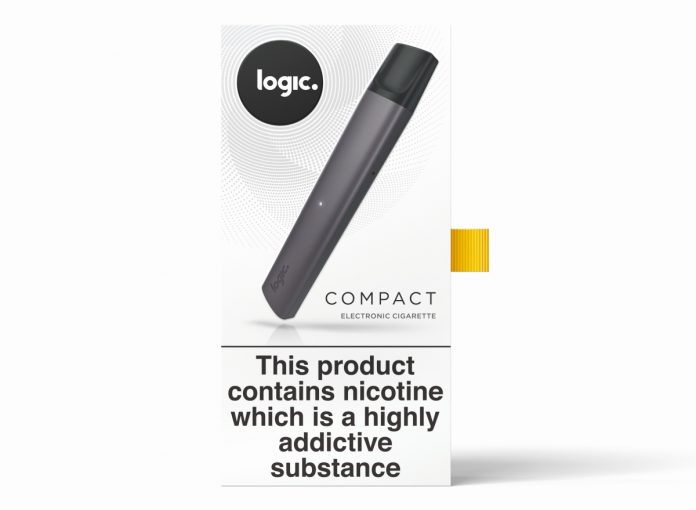EXCLUSIVE: JTI’s vaping boss Nick Geens speaks to Vape Business
January 15, 2020

At our first Vape Business Conference last summer Nick Geens of Japan Tobacco International (JTI), whose UK headquarters are in leafy Weybridge, presented a memorable keynote address that mapped out the extent of the smoking territory vape will soon occupy.
Six months later we are here at Vape Business Towers to catch up with all that has happened in a hectic and even breathless interim, and to look forward – we hope with “2020” vision – to upcoming trends and events in the new year.
Nick is a tall, Flemish-speaking Belgian who now calls Clapham home, and whom I naively believed was Head of Vaping Business at JTI.
“Yeah, we call it Head of RRP – Reduced Risk Products – but Vaping Business is probably more human language,” he laughs.
Getting straight to business, I ask Nick what he would highlight as the biggest thing to have happened at JTI since we saw him in July, and he has no hesitation in replying.
“It’s been a key year for us in the pod-vaping segment, and you have noticed for sure that the pod-vaping business is continuously growing,” he says. “And for us, specifically in JTI, we had a very exciting development with the launch of our nicotine salt pods – Logic Compact Intense.”
JTI is one of the Big Five vape producers – along with BAT (Vype), Imperial (blu), PMI (the heat-not-burn IQOS) and now Juul. With its products available in all channels across the nation, JTI is at the forefront of a technological race to extend, consolidate and
dominate what has so far been a fragmented vape market.
“Logic is distributed everywhere in wholesale and you will find our products throughout the country, well-distributed in wholesale depots,” Nick says. “We have fully national trade reps as well who you can talk to, to find out about the products and get advice about how to retail them, how to merchandise and sell them.
And of course there is JTI advance [https://jtiadvance.co.uk/] where you can get lots of information as well.”
JTI has also recently begun to trial its Vape Gallery gantry, which showcases the Logic vape range but also allows facings of other products and brands. “We are still in the early pilot phase and we want to roll it out next year,” he says. “The intention of Vape Gallery is to have an accurate reflection of what the vape category is. I think very often retailers are challenged with: ‘Which products should I stock and how do I compete with the vape shop down the high street? They seem to have a very different range of products than I can find in my local wholesale depot.’”
Nevertheless it is true that vape in convenience has suffered from the mix of 40,000 different products and over 600 manufacturers, which has often spelled confusion for all but specialist retailers and vape hobbyists, with their expert talk of open and closed tanks, freestyle vapes, ohms, coils, big clouds and whatnot.

“Open tanks require a wide range of bottles to stock – a lot of brands, a lot of flavours, a lot of different variety,” Nick admits. “Which is a good thing if you want to be successful in the open-tank business.” In short, the problem is that both Convenience retailers and potential consumers of vape – meaning current smokers amenable to switching – are put off by a lack of certainty, availability and understanding. What can retailers do about it?
“First of all, on the range and what you need to stock, the only advice I could give would be to stick with your reliable brands and partners,” Nick says. “I often hear when I talk to retailers that there are a lot of smaller companies coming in, trying with a lot of products on the counter and then you never see them again.
“If you get a consumer buying that brand, you can’t restock or you don’t know what to do with your old product; is it compliant, yes or no? If I had a shop I would definitely advise to stick with a couple of the big brands and make sure I get good service, get a rep who will service me, I can find that brand in different wholesale depots.”
Vape Gallery, then, is JTI’s solution to the current market situation. “It is managed by us through a third-party and they will supply the products but it is a range of brands, a range of flavours, a range of product types, and it gives that offer and that variety to consumers,” Nick confirms.
The retail vape market has been growing steadily but according to Nick remains a fraction of the overall RRP segment, with sales of 20 per cent in the convenience and other traditional channels but 80 per cent still through vape specialists outlets, much of it online.
“I do think that the ratio will change,” Nick says. “I think 20-80 was almost the extreme for open-tanks and bottles and vape stores and online retailers who were very popular and very successful. And we have already seen that scale tipping into the other direction.”
The reason for the polarity starting to swing around is the increasing availability and popularity of the pods Nick mentioned, along
with the exotic sounding “nicotine salts” – and other possibly watershed-scale events, of which more later.
“It is not yet 50-50 by any means,” says Nick of the growing Convenience share, “but I think the trend is curbing, so you see that convenience and traditional brick-and-mortar retail is picking up a larger and larger piece of the pie. I think we are probably now close to 30 per cent and in the future I do see that continuously growing.”
Off to the Pod races JTI’s vape offer, Logic, which it had been steadily brand-building since it dove into the vape sector with the buyout of the US company Logic Technology Development in 2015, began with Logic LQD – its open-tank version of vaping, which is where the market was at, half a decade ago.
That was followed by Logic PRO, JTI’s original closed-tank system using pre-filled e-liquid capsules. That innovation was an appeal to smokers to switch, with its easily swappable cartridges and – importantly – a range of flavours. Simplicity and utility were already the watchwords when, in September 2018, Logic Compact became available in the UK. Again, technology had marched a bit further, offering as well as capsules a more consumerfriendly and sleeker design with – crucially – a powerful 350mAh battery and improved taste and satisfaction more closely resembling a traditional smoking experience.
Which brings us to 2019 – “And for us, specifically in JTI, we had a very exciting development with the launch of our nicotine salt pods – Logic Compact Intense,” says Nick.
Capsule devices have come to be referred to as “pods”, and they are the devices the big manufacturers are hoping will snag ever-larger numbers of smokers and convert them to vaping. The standardisation and ease of use – not to mention the advantageous pricing – is the charm in developing a real mass market in
vape.
“Pod sales make it easier for Convenience retailers because there are fewer brands and fewer products out there,” Nick says. “So it basically consolidates the range and makes it more convenient to sell in a Convenience environment.”
One big problem in the past has been smoker satisfaction, but vape tech is advancing on all fronts. “Nicotine salts is a strong trend so we have developed Compact Intense,” he explains. “Our strategy is always based on following consumer demand. We also try to forecast consumer demand and see where technology is going, and we try to develop products that are at the highest performance and in the best interests of consumers.” Usually with vape a nicotine solution is added to a mix of vegetable glycerin and propylene glycol that delivers the nicotine when heated and inhaled. It’s OK but can be
distasteful (hence all the flavours to cover it up).
In addition, it doesn’t quite supply the “hit” at the back of the throat that dedicated smokers crave, and the nicotine enters the bloodstream relatively slowly. Nicotine salts instead use the salts from the tobacco leaf as the transport into the body – a faster hit, less acidic (salt is alkaline) and available at a lower temperature, so less harsh to inhale. “The advantage for consumers is that the vape products with nicotine salts – and we have seen this as a new trend that is coming to the market – it gives a more intense flavour delivery, so you get a richer vaping experience altogether, which is better compared to the standard range of vaping nicotine liquids,” Nick explains.
Vaping via nicotine salts is more closely akin to a real cigarette but still without the harm from chemicals released in smoke, and with more bang for your buck flavour-wise. Nick believes that demand really is out there now, and that JTI’s Compact Intense pods will further spread the appeal.
“We have always known what is our next big thing,” he says. “The UK is one of the most innovative and developed vaping markets in the world, so obviously from a global perspective the UK is usually the first market to see new JTI products.” “Menthol ban – what is that?” We are also both thinking about another huge issue that could perhaps be an inflectionpoint in the attempt to convert traditional tobacco smokers to vape: the upcoming EU menthol ban due to come into force on 20 May. What menthol ban? I hear you ask. Exactly. In 2014 the UK signed up to a Brussels protocol called the Tobacco Products Directive (TPD) which regulates smoking and tobacco laws across the EU area. Retailers will be delighted to know that if they sell a packet of regular menthol cigarettes after May 20 they could face three months (and up to two years) in prison. There is no sell-through period. Leftover stock will instantly become contraband.
“The menthol ban is a little bit wider than just that,” adds Nick. “It is a tobacco fl avour ban, so the products that will be mainly impacted are menthol cigarettes and capsule cigarettes, which has been a growing segment in the market recently. The thinking behind it is, obviously, that it is on the scale of ever-increasing regulation from an EU point of view.”
Brexit does not exempt the UK from the TPD obligations the UK signed on for, so menthol cigarettes will soon be history. Unfortunately, as Michael Caine might say, not a lot of people know that – certainly not many retailers and apparently, from our anecdotal research, hardly any menthol smokers.
The positive for the vape market will come from the roughly 20 per cent of smokers who prefer menthol. Most of them will be susceptible to carrying on getting their menthol hit from other avenues than traditional tobacco. Now is the time to begin alerting your customers, and explaining the attractions of vaping menthol
instead.
“We will make sure we communicate to our retailers leading up to May 2020, using the usual channels, be it our reps, who will have all the information on the menthol ban; JTI Advance, our online trade platform; and newsletters that will be going out,” says Nick. “But traditional opportunities for retailers and for companies are still there. The thinking at JTI is very much – and I think retailers could take it on-board as well – that [the menthol ban] is still six months away. So for now I think it is very much recommended to continue your best practises as usual. That means stock the full range, make sure the
products are available and apply competitive pricing.

Because there is going to be a market for menthol products over the next few months,” he states reassuringly.
It is a vexed question exactly how many people that 20 per cent of smokers represents. JTI estimates there are just under two million UK vapers now, with eight million smokers (so two million potential new menthol vapers). Others claim seven million UK smokers – twice the number of their estimate of 3.5 million current vapers. What are the real numbers and how are they calculated?
“It is indeed difficult to estimate the exact number of vapers, and it all depends on the definition that you apply,” Nick says. “Some consider that as soon as you have tried vaping once in your life, we count you as a vaper. Others go all the way to the other end of the spectrum and say that the only way you are a person who vapes is if you do it every week. So that would bring your difference to between three million vapers or one million vapers. JTI tries to go a little bit more in the middle of the spectrum, so we say at least you need to vape once a month to be considered by us a vaper.
That’s why we end up with a number that rounds up between 1.5 and two million vapers.”
That’s surely good news because if only two million people vape, it means there’s up to eight million more smokers still to convert.
“Yes there is still growth, absolutely,” Nick replies with classic Belgian understatement. So we enter 2020 with a burgeoning vape market, a rapidly improving pod technology with a nicotine salt app that will bring in many smokers who might have been previously unimpressed, a turbo-boost from the EU menthol and flavour ban … is there anything else that might help? Like a new pro free-market government and Brexit in only a month’s time, perhaps?
“It looks more likely now that Brexit will take place with the recent election results,” Nick says. “I am sure it is not going to be the very fi rst priority for the new government, but they have given signs that once Brexit is in place that the UK government would be willing to look into softening the regulations on vaping.”
The recent ASA ruling against BAT for advertising on Instagram seemed draconian and anti-vape – and it should be noted BAT have explicitly denied “fake news” that Vype has been “banned” from Instagram. But lobbying against vape is alive and well from various self-interested quarters.
“Yes, it’s true,” Nick agrees.
“There is a general animosity against nicotine sometimes, which is not necessarily fair or correct and in the best interests of consumers. We see that products containing nicotine but that don’t combust – such as vaping – have up to a 95 per cent reduced impact on health as recommended by PHE. “There are certain bodies and authorities out there who seem to be waging war against nicotine altogether, which is not always justifi ed, because there is evidence out there to suggest that there is a significant potential benefit of reducing risk for consumers in products that still contain nicotine.”
The UK, in contrast to the recent vape panic in the USA and the nationwide ban in India, seems an outpost of sanity – should we expect more tolerance and
long-term vison from the new government?
“We expect them – mostly in terms of communication and advertising – to loosen up on the regulation because the UK authorities are clear in their belief in the RRP potential of vaping products,” Nick reveals. “And I think, if we get Brexit done and we get on to normal regulation again, we can also close the loophole of unregulated zero-nicotine liquids and bring some consolidation to the market.”
Zero nicotine? “I mentioned at the conference, zero-nicotine products are still not regulated in the UK market,” Nick explains, “so you have the phenomenon of short-fi lls, which is probably a very big part of what is out there in the vape channel in the specialised vape retailers.” It certainly looks like a bright start to the new year, in that case. Isn’t it also a good feeling to be working in an area that is a net positive for health, being involved in saving very many lives of ex-smokers over the next decade.
“I think vape products have an immense benefit for the adult global smoking population,” Nick says. “It has proven successful in countries such as the USA, the UK and other European countries. I think over time products will only get better and consumers will embrace vaping products more and more. I think over the next couple of years we will see more technology and more relevant products for consumers. So I think it’s only going one way, and that is up.”
And that is 2020 vision – “For sure,” as Nick would say.
